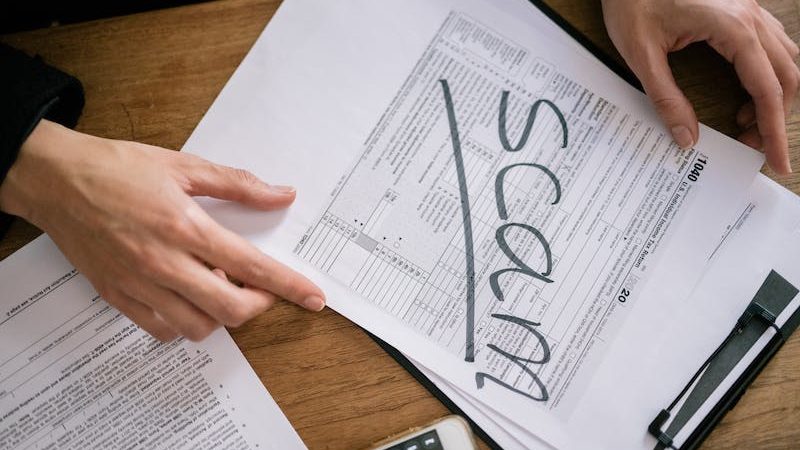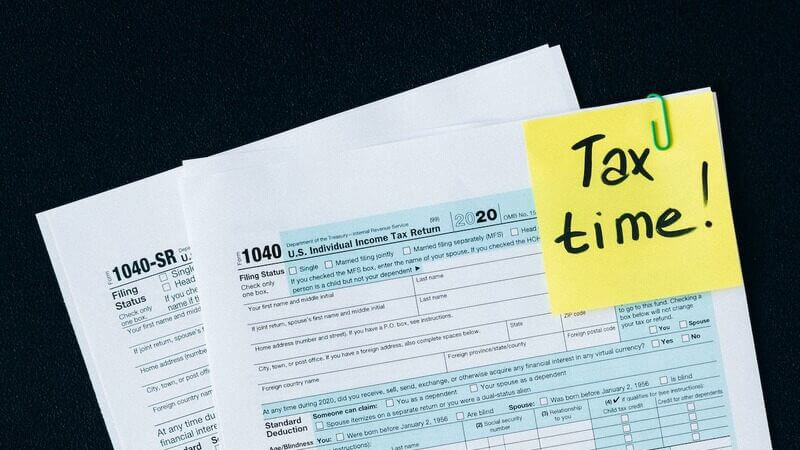Tax Frauds: How to Protect Yourself from Fraudulent Schemes

Credit: Leeloo TheFirst
Scams are serious business, with consumers losing about $8.8 billion to fraud in 2022. This is an increase of more than 30 percent since 2021, making it more important than ever that we protect ourselves.
Here’s the thing:
Identity fraud can happen to any of us. Other types of scams can get us, too. Even if you’re cautious, there’s no guarantee.
But that doesn’t mean you shouldn’t take measures to protect yourself!
This is especially important at tax time. We put a lot of information on our tax forms, including our full name, social security number, income, employer, and dependents.
Imagine if that information fell into the wrong hands.
And that doesn’t even count the scams where someone convinces you to hand over money or download malware onto your computer.
But knowledge is power. That’s why the IRS keeps a list of the different types of tax scams to help us know how these things work. Then we can take measures to protect ourselves.
Ready?
Let’s look at a few ways tax scams can hit you not only at tax time but throughout the year.
What Is Tax Fraud?
A tax fraud is a type of fraud that’s specific to your tax return. It could be that someone promises to settle your tax debt, or maybe you get an email that looks legitimate but encourages you to click.
For IRS purposes, tax fraud can take two forms. There’s the fraud a taxpayer commits against the IRS by, say, falsifying information. But then there’s the fraud a scammer commits against a taxpayer. Today, we’re talking about the latter.
Financial and identity scams can happen any time of year. With a tax fraud scam, though, the activity specifically targets you as a taxpayer. They can come after your tax return, use your social security number to file as you, or convince you to hand over cold, hard cash.
Scammers stand to benefit from tax fraud in a variety of ways.
In some cases, they’re simply after your money. By saying you owe the IRS, they figure they can convince you to hand over cold, hard cash. You click on a link and give your credit card number and next thing you know, money is out of your account and in theirs.
But there’s another way scammers can steal your money. By beating you to the punch on filing a return under your social security number, they might just nab your refund.
The worst type of scam, though, doesn’t immediately hit your bank balance. If fraudsters can capture your personally identifiable information (PII), they can continue to use it long after tax season has come and gone.
However it happens, being aware of the dangers is an important first step in reducing our risks.
Each year, the IRS releases a list of scams currently impacting taxpayers. In 2022, the list included some that have been around a while, along with a few that have come along in recent years.
9 Types of Tax Frauds
- Phone scams
- Phishing scams
- Payment overdue scams
- Social Security number suspended alerts
- Duplicate return scams
- Data breaches
- Fishy tax preparers
- Stimulus payment fraud
- Taxpayer assistance scams
There are nine different types of tax scams that people should be aware of. These scams can involve various tactics, such as phishing, identity theft, and fake charities. It’s essential to stay vigilant and protect your personal and financial information to avoid falling victim to these scams.
1. Phone scams
What is it? A call from the IRS can be scary. The good news is, that the IRS doesn’t make phone calls. Scammers do, though. If you do answer the phone when “the IRS” calls, this type of scam is an attempt to get your money. It’s theft, plain and simple.
How to spot it: These scammers typically operate through fear tactics. If someone threatens you with law enforcement or demands payment by phone, it’s a telltale sign it’s a phone scam. The IRS does neither of those things. If you owe, you’ll receive a bill in the mail.
How to avoid it: If you get a phone call from someone claiming to be from the IRS, hang up and call 800-366-4484 to report it. Watch your mail closely for any communications from the IRS.
2. Phishing scams
What is it? Text and email have both become popular ways for scammers to impersonate IRS agents. With a phishing scam, you’ll get a message with a link. When you click on that link, you may be asked to log into a website and provide PII or payment information. This is phishing. The person at the other end of that message collects that information and uses it.
How to spot it: As with phone calls, these messages will often be threatening. They’re designed to scare you into taking action. The IRS doesn’t send messages through text and email, so the fact that you’re getting this type of message at all is a red flag.
How to avoid it: Never click on unexpected links. When in doubt, go directly to the website and input the necessary information there.
3. Payment overdue scams
What is it? This type of scam notifies you, the taxpayer, that you received too much money in tax refunds. You’re then told you need to pay that money back immediately to avoid further action.
How to spot it: A demand for immediate payment is not the IRS’s style. If you do owe money, you’re provided information on how to appeal. If a message demands money through specific methods, such as a wire transfer or prepaid debit card, it’s a scam. The IRS also never asks for credit card information by phone.
How to avoid it: Watch for a letter in the mail. If your refund is an overpayment, you’ll get a bill on official IRS letterhead.
4. Social Security number suspended alerts
What is it? “Your social security number has been suspended.” Those can be scary words. The good news is, that doesn’t happen. Your social security number is yours from the day it’s issued, and anyone telling you otherwise is scamming you.
How to spot it: Anyone contacting you claiming to be from either the IRS or Social Security Administration is likely up to something sketchy.
How to avoid it: Never give out your social security number or pay someone claiming your number has been suspended. Hang up the phone and call the SSA or the IRS if you have questions.
5. Duplicate return scams
What is it? If someone has your name and social security number, they can file a tax return as you. That means any money you’re due could be redirected to a tax scammer.
How to spot it: If a duplicate return has been filed on your behalf, you’ll likely either get a letter from the IRS about a suspicious return or you’ll be rejected when you try to e-file. In some cases, you’ll learn that someone has created an online account using your name.
How to avoid it: The sooner you can take action on a duplicate return, the better. Contact the IRS to stop any further action on the erroneous return. You might need to complete the form at Identity Theft Affidavit. IdentityTheft.gov also has valuable information to help you recover if your social security number has been stolen.
6. Data breaches
What is it? In 2022, there were 1,802 data breaches in the U.S., with instances escalating in the latter half of the year. With a data breach, criminals gather data that they can then use for theft. If those breaches result in your social security number and contact information being swiped, that data can be used to file fraudulent returns.
How to spot it: Businesses are required by law to notify customers of a data breach, but sadly, the first sign usually doesn’t come until suspicious activity starts happening. Monitor your credit report and look for instances where someone might be using your number to secure credit.
How to avoid it: Try to safeguard your data, providing your social security number only when absolutely necessary.
7. Fishy tax preparers
What is it? Not all tax preparers are on the up and up. Some will promise the moon and deliver…less than that. A sketchy tax preparer promises to help you reduce your tax burden, increase your tax return, or wiggle your way out of your IRS debt.
How to spot it: A tax preparer’s job is to help you legally file your taxes. Skip anyone who makes big promises and look for a preparer who simply promises to get your return in on time.
How to avoid it: Look for referrals and carefully research any tax preparer you’re considering. If you have IRS debt, contact the agency directly to find out what options are available to help resolve it.
8. Stimulus payment fraud
What is it? From time to time, the IRS offers taxpayer relief in the form of stimulus payments. Unfortunately, this brings scammers out of the woodwork.
How to spot it: As with other types of tax fraud, scammers will reach out requesting information like your social security or credit card number.
How to avoid it: When stimulus payments are available, the IRS will create an informational section on its website. Check here for any information and avoid communicating by phone, email, or text with anyone claiming to be the IRS.
9. Taxpayer assistance scams
What is it? Over the years, taxpayer assistance agencies have emerged, promising to help taxpayers with their tax debt.
How to spot it: Often called “taxpayer advocate services,” these companies try to imitate the free taxpayer centers set up by the IRS.
How to avoid it: Avoid anyone promising to help you who isn’t a legitimate tax preparer or directly affiliated with the government.
Now that we’ve gone through the different types of scams, it’s time to look at what we can do to reduce our risks.
How To Protect Your Identity And Your Money?

Photo by Kelly Sikkema
I’ve thrown a lot of information your way, and I know it can be a little overwhelming.
“What am I supposed to do with all this?” you may ask.
Yes, there are things you can do to reduce your tax fraud risk. It’s not guaranteed, but every little bit helps, right?
You might think about tax fraud at tax time, but these are all things to do the rest of the year, too. Not only is it good practice, but some of these scams can hit you long after you’ve spent your refund.
1. Never Click on Links
“I have a great offer for you. Just click here to learn more.”
We’ve all gotten some pretty tempting emails in the past. And we’ve trained our fingers to hover and click when we see underlined blue words. But whatever you do, don’t click! Even if an email or text looks oh-so-real.
Here’s why:
Cyber scammers can easily fake an email using something called spoofing. They can copy the look and feel of a legitimate organization like, say, the IRS. They can send some pretty scary language that scares you into clicking.
Some examples:
- “Issue: Unreported/Underreported Income.”
- “Final demand for payment.”
- “We have detected some incorrect information on your tax return account.”
- “The IRS is filing a lawsuit against you.”
On the opposite end, they might have positive language that entices you to click, like:
- “We have determined that you are eligible for a tax refund.”
- “We identified an error in the calculation of your tax.”
What happens when you click? You’re typically taken to a site where you’re directed to input sensitive information. This could be your social security number, banking information, payment information, or simply your name and address. Either way, someone has your personal details and can use them.
But I think we’ve all clicked before and not been asked for that type of information. In that case, we’re still at risk. With that one click, we might have dropped some software onto our device without us even realizing it. This type of malware can grab your private information, and that information can be used to steal your identity (or money), as well.
The thing is:
You don’t have to click. Nope. If you’re due a refund, you can check the status through the IRS’s Where’s My Refund? portal. You can also report the suspicious email at phishing@irs.gov.
I know I told you earlier that the IRS communicates primarily via snail mail. But scammers know that and have learned to reach people that way. That means even that piece of paper in your mailbox with the realistic letterhead could be fake.
First, compare the letter to the letters online to make sure it looks identical. Also, look for typos and grammatical errors. The IRS’s communications are very boilerplate, and that means obvious errors are highly unlikely.
If you’re truly afraid to disregard the letter, you can always try to call the IRS during office hours and ask if the message is legit. The number is 800-829-1040. One warning: wait times can be excruciatingly long, especially during tax season.
Dealing with phone calls:
If you’ve received a phone call that you suspect is a scam, reach out to the IRS immediately. The U.S. Department of the Treasury has set up a website for reporting fraud, scams, and abuse. Provide as much description as possible of the communication. This is where taking action quickly can help since you’ll remember those details better.
Some apps let you forward voicemail messages. If you have that feature, you can forward the message to the IRS at phishing@irs.gov.
Social media messages, posts, and comments can also be copied and forwarded to the IRS.
If someone has threatened you with arrest, don’t panic. Simply report the incident to the IRS using as much detail as possible.
2. Use Malware Protection
You’ve vowed to never click on a link in email or text again. So, you may ask, why would you need malware protection?
The answer:
You can never be too careful.
Investing in solid malware protection for all your devices can give you that extra layer you need. I don’t know about you, but I don’t worry quite as much when I’m on my device. Every now and then, my malware protection warns me when something weird is happening in the background.
Also, make sure your home Wi-Fi is locked so you don’t have neighbors and passersby hopping on and using it. This should be turned on by default. If it’s on, you’ll have a lock pictured next to your Wi-Fi name on the list on your devices.
You should also change the password of your home’s Wi-Fi. There’s usually a default password that you can easily change. Be sure to use complex passwords. We’ll discuss that in a minute.
If you routinely use your devices on public Wi-Fi, you might also want to look into a virtual private network (VPN). You can use this whenever you’re away from home to safeguard your laptop. Your malware protection might include this feature as an add-on, or you can find plenty of other tools.
You can also add identity theft protection as a security layer. These services monitor your credit and alert you of any suspicious activity. This can help you take action as quickly as possible if your credentials are ever stolen.
3. Watch Your Password Hygiene And Use A Password Manager
You visit a site after being away from it for a while. It wants your password. What do you do?
Do you…
- Grab a book or sticky note next to your computer for a cheat sheet of passwords?
- Use one of two or three passwords you use literally everywhere?
- Reset the password in frustration because it’s too long, complex, and unique to ever remember?
If you answered number 3, ding ding ding! That’s the right answer.
Your passwords should be as tough to guess as possible. Here are some tips:
As painful as that last one can be, you can use password managers that make keeping up with everything automatic. Just change the password for your password manager often and make sure you comply with the tips above.
Many sites now use multifactor authentication, which sends a code to another device you own before letting you in. This is especially important with financial sites.
4. Know the Signs
There’s some good news in all this, though. Chances are, a tax scam will never hit you.
But even if it does, there’s something you can do to minimize damage. The biggest thing is to watch for signs and, when you see them, take action.
If you’re ever a victim of identity theft under any circumstance, complete Form 14039: Identity Theft Affidavit. This will alert the IRS to watch for any suspicious returns using your information.
The IRS also has a process for requesting a copy of a return that might have been fraudulently submitted under your social security number.
For a little extra protection, the IRS will issue a six-digit PIN number that will ensure only you can submit tax returns for your social security number.
Also, the IRS maintains a news section where you’ll find the latest scams impacting taxpayers. Keep an eye on that page throughout the year, especially during tax season, and check there first if you receive any IRS communication.
Lastly, Google is your friend. Whether it’s a notice in the mail or a strange phone call, you can simply input any notice numbers or specific wording and find answers.
5. Take Care at Tax Time
At the start of each year, attention turns to taxes. Suddenly, it seems everywhere you look, something’s reminding you the tax deadline is approaching.
Scammers are aware of it, too. From January to April each year, scammers bump things up a notch, knowing people are preparing, filing, and waiting for returns.
While you can still receive tax notices long after April 15th, there are some extra measures to take during those first few months of the year.
File Early (and File Electronically)
If you wait until April 15th at midnight to hit “submit” on your return, you risk someone else filing on your behalf.
But, like me, you probably dread doing your taxes. That makes it easy to put things off.
One way to reduce your risk, though, is to simply file early. By filing early, you reduce the chance that someone else will swoop in and claim your refund.
Filing electronically will ensure your return gets from you to the IRS faster. It also cuts the risk that someone will intercept your paperwork along the way, giving them access to all your sensitive information.
Avoid Tax Scammers
If you need tax help, there’s no shortage of ways to find it.
You can file your own taxes, using IRS e-file (if you qualify) or third-party tax preparation software. Some of these tools offer expert assistance through video and text chat.
Of course, you can also see someone in person. There are franchise tax preparation services and local service providers. Each has its own system for charging fees, and some are more skilled and experienced than others.
To be safe, ask around for referrals and check online reviews. Avoid preparers who make promises about the refunds they can help you get. Also, carefully read the entire return before signing off on it, and if you have any questions or concerns, ask!
✎ Related: How Does Tax Identity Theft Occur? ➔
How to Determine if You Have Been a Victim of Tax Fraud or Scam?

Photo by Nataliya Vaitkevich
No matter how diligent we are, scammers can find us. In fact, they seem to be getting more innovative with each passing year. If you are eventually scammed, it’s important to catch it as quickly as possible to prevent further damage.
Here are a few signs you’ve been scammed:
What Should You Do If You Become A Target of Tax-related Scams?
If you discover you’re a victim of a tax scam, it’s important to take action immediately. You can forward correspondence to phishing@irs.gov. For phone calls, email, and mail scams, you can use the Department of Treasury’s scam report.
Request a copy of any fraudulent returns filed under your social security number using IRS Form 4506-F.
You can report sketchy tax preparers using the IRS’s Tax Preparer Complaint form.
The words “tax fraud” can sound a little scary. But it’s important to protect your financial and personal information whenever you can. Once you’ve adopted those habits, you’ll not only have peace of mind during tax season but throughout the year.
✎ Read on to learn about some common financial scams and how you can steer clear of them:



